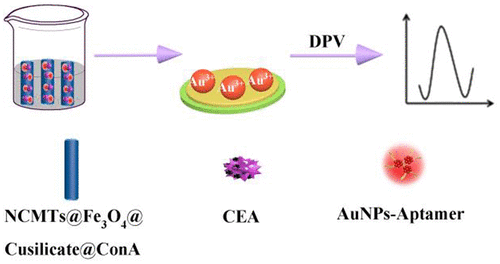当前位置:
X-MOL 学术
›
ACS Appl. Nano Mater.
›
论文详情
Our official English website, www.x-mol.net, welcomes your
feedback! (Note: you will need to create a separate account there.)
Electrochemical Aptasensor of Carcinoembryonic Antigen Based on Concanavalin A-Functionalized Magnetic Copper Silicate Carbon Microtubes and Gold-Nanocluster-Assisted Signal Amplification
ACS Applied Nano Materials ( IF 5.3 ) Pub Date : 2020-04-03 , DOI: 10.1021/acsanm.0c00194
Jing Zheng 1 , Jianping Wang 1 , Dandan Song 1 , Jingli Xu 1 , Min Zhang 1
ACS Applied Nano Materials ( IF 5.3 ) Pub Date : 2020-04-03 , DOI: 10.1021/acsanm.0c00194
Jing Zheng 1 , Jianping Wang 1 , Dandan Song 1 , Jingli Xu 1 , Min Zhang 1
Affiliation

|
An ultrasensitive electrochemical sensor was developed for the quantitative determination of carcinoembryonic antigen (CEA), which is often utilized as a tumor marker and a prognostic indicator. In the paper, first, copper silicate integrated with nitrogen-doped magnetic carbon microtubes (NCMTs@Fe3O4@Cusilicate) was synthesized and employed to enrich concanavalin A (ConA), which can be used as an affinity probe to selectively capture CEA. Through chemical chelation between a copper ion and Con A, the combination of Cusilicate/ConA was greatly improved. Furthermore, gold nanoclusters (AuNCs) immobilized with aptamers were provided for signal amplification. Thus, in the presence of the target protein, CEA, in a sandwich manner, was formed, and AuNCs were gathered on the electrode through a magnetic field. Electrochemical oxidation of AuNCs to AuCl4– was performed, and immediately differential pulse voltammetry was performed, resulting in an electrochemical response because of the reduction of AuCl4–. On the basis of these merits, the constructed sensing system provided a ultrasensitive detection scheme for CEA with a linear range from 0.03 to 6.00 ng·mL–1 and a low detection limit of 5.38 pg·mL–1. In addition, the proposed strategy was employed to detect CEA in serum, which showed excellent correlations with standard immunoassay. The excellent performance indicated that the proposed sensor has significant potential for clinical diagnosis.
中文翻译:

基于伴刀豆球蛋白A功能的磁性硅酸铜碳微管和金纳米簇辅助信号放大的癌胚抗原电化学适应传感器
开发了一种超灵敏的电化学传感器,用于定量测定癌胚抗原(CEA),该抗原通常用作肿瘤标志物和预后指标。在本文中,首先,将硅酸铜与掺氮磁性碳微管(NCMTs @ Fe 3 O 4)集成在一起。合成)并用于富集伴刀豆球蛋白A(ConA),其可用作亲和探针以选择性捕获CEA。通过铜离子和Con A之间的化学螯合,大大改善了Cu硅酸盐/ ConA的结合。此外,提供了固定有适体的金纳米簇(AuNCs)用于信号放大。因此,在目标蛋白质的存在下,以夹心方式形成CEA,并且AuNC通过磁场聚集在电极上。进行了AuNCs电化学氧化为AuCl 4 –的反应,并立即进行了差动脉冲伏安法,由于AuCl 4 –的还原,导致了电化学反应。。基于这些优点,所构建的传感系统为CEA提供了一种超灵敏的检测方案,其线性范围为0.03至6.00 ng·mL –1,检测下限为5.38 pg·mL –1。此外,所提出的策略被用于检测血清中的CEA,这与标准免疫测定法显示出极好的相关性。出色的性能表明,所提出的传感器具有重大的临床诊断潜力。
更新日期:2020-04-03
中文翻译:

基于伴刀豆球蛋白A功能的磁性硅酸铜碳微管和金纳米簇辅助信号放大的癌胚抗原电化学适应传感器
开发了一种超灵敏的电化学传感器,用于定量测定癌胚抗原(CEA),该抗原通常用作肿瘤标志物和预后指标。在本文中,首先,将硅酸铜与掺氮磁性碳微管(NCMTs @ Fe 3 O 4)集成在一起。合成)并用于富集伴刀豆球蛋白A(ConA),其可用作亲和探针以选择性捕获CEA。通过铜离子和Con A之间的化学螯合,大大改善了Cu硅酸盐/ ConA的结合。此外,提供了固定有适体的金纳米簇(AuNCs)用于信号放大。因此,在目标蛋白质的存在下,以夹心方式形成CEA,并且AuNC通过磁场聚集在电极上。进行了AuNCs电化学氧化为AuCl 4 –的反应,并立即进行了差动脉冲伏安法,由于AuCl 4 –的还原,导致了电化学反应。。基于这些优点,所构建的传感系统为CEA提供了一种超灵敏的检测方案,其线性范围为0.03至6.00 ng·mL –1,检测下限为5.38 pg·mL –1。此外,所提出的策略被用于检测血清中的CEA,这与标准免疫测定法显示出极好的相关性。出色的性能表明,所提出的传感器具有重大的临床诊断潜力。

































 京公网安备 11010802027423号
京公网安备 11010802027423号